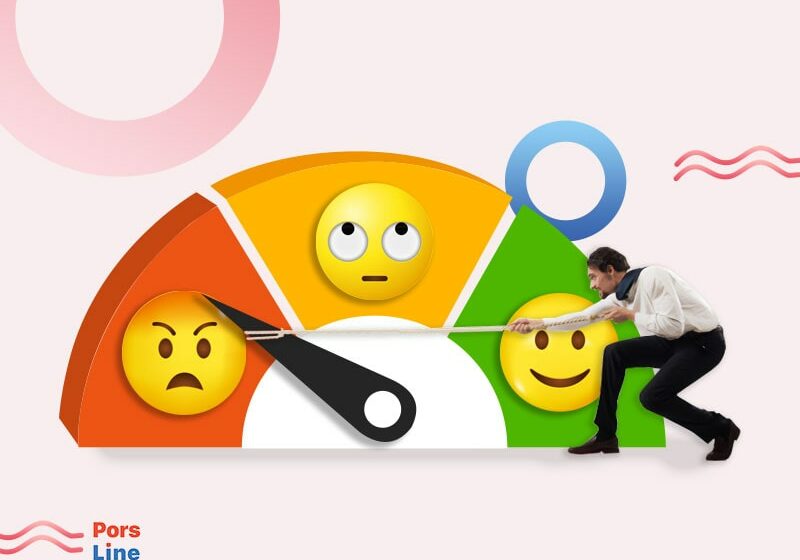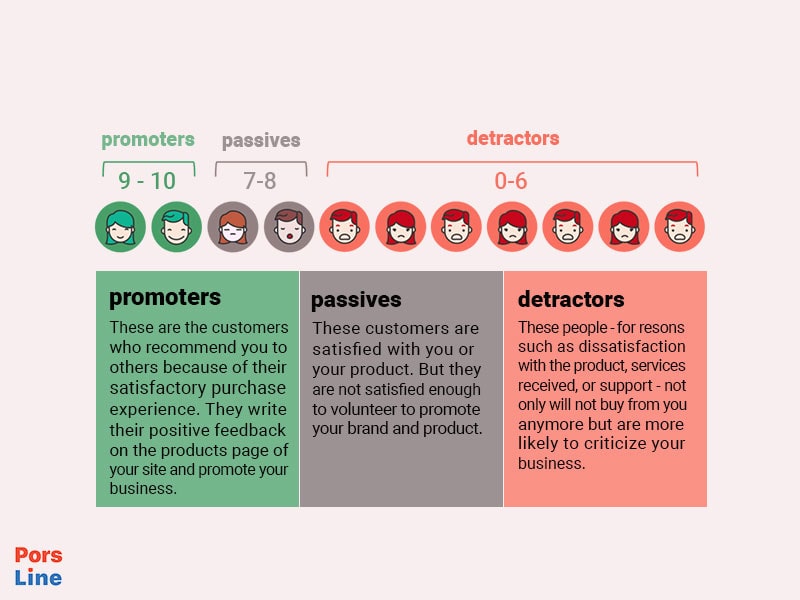The Net Promoter Score (NPS) and its Applications

«How likely is it that you would recommend us to your friends?»
That is the last sentence your customers are expecting to hear. Actually, recommending a product/service or company to someone else is not something that can be achieved simply based on your request from the customer. It is the experience of satisfied customers while receiving your services or using your products that prompts them to do so. However, creating a mechanism to measure a customer’s willingness to recommend you is a smart and necessary step. This is where the Net Promoter Score or NPS index comes into play.
The Net Promoter Score (NPS) Index is a metric used to measure the level of customer loyalty to your business or brand. Being simple and fast to use, this method has recently become a popular tool for measuring customer loyalty and predicting company growth. More than two-thirds of leading companies featured in Fortune magazine such as Apple, Facebook, and HP are currently using this index.
In this post, we will thoroughly introduce the concept of this index, how it is measured, and its application in organizations.
A closer look at the concept of the NPS index
The Net Promoter Score index is one of the valid metrics used in evaluating customer experience and satisfaction. It shows how likely your customers are to recommend or promote your business, product, or service.
The main question for determining this index is:
«On a scale of 0 to 10, how likely are you to recommend our business to a friend or colleague?»
Respondents give a rating between 0 (not at all likely) and 10 (extremely likely) and, depending on their response, customers fall into one of the following three categories to establish an NPS score:
- Promoters:
People who respond with a score of 9 or 10 are placed in this group. These are the customers who recommend you to others because of their satisfactory purchase experience. They write their positive feedback on the products page of your site and promote your business.
- Passive:
People who respond with a score of 7 or 8 are placed in this category. Although these customers are satisfied with you or your product, they are not satisfied enough to volunteer to defend or promote your brand and product.
- Detractors:
People who give this question a score from 0 to 6 are the ones who disapprove your business. And those people—for reasons such as dissatisfaction with the product, services received, or support—not only will not buy from you anymore but are also more likely to criticize your business.

How and why to implement the NPS index in business?
Fred Reichheld first introduced the Promoter Index in 2003 as one of the important metrics in customer experience.
He calls the fundamental question “Do you recommend us to others?” the (ultimate question) and considers it the main predictor of business growth.
He explains this index, its importance, how it is measured, and how its results are analyzed in his article «The One Number You Need to Grow» in the (Harvard Business Review) and in his other subsequent books.
According to Fred Reichheld, NPS distinguishes between good and bad profits by segmenting customers into three groups: «promoters», «detractors» and «passive». He thinks that the revenue and profits generated from detractors are considered negative and bad profits. While the profits from customers who become promoters are positive.
NPS index and NPS system are currently registered as brands and services for Fred Reichheld, Bain & Company, Inc., and Satmetrics Systems, Inc.
The publication of Reichheld’s writings drew the attention of businesses worldwide to start measuring this index. In addition, the design and implementation of the NPS survey have been added to the organization’s agenda.
A Full Guide to Evaluating and Improving Customer Experience Management + some Recommended Books
NPS survey design: How does the NPS index work?
Organizations can calculate this index by designing an NPS survey and asking their customers two simple questions.
- The First question – A Likert Scale question: How likely are you to recommend our service/brand/product to your friends or colleagues?
This question is of the Likert scale question type, and its answer is in the numerical range from 0 to 10.
- The second question – An Open-ended question: What is the main reason for this rating? What made you satisfied or dissatisfied?
This question is often posed as a text question (open-ended question) or a multi-choice question. The answer to this question will help you better plan your next steps.
In general, you only ask the customer about the reason behind the rating they gave. But, in order to gather more information, you can ask questions such as “What was missing or disappointing in our product/service? How can we improve our product or service? Which of our features were useful to you? What challenge does our product solve for you?”.
Using the Porsline Survey Builder features, you can create this survey and calculate your business Net Promoter Index by sending it to your customers via SMS or email. Also, you can show the survey on your website using the “Embed on website” option.
View and use the Net Promoter Score Index survey template
Calculating the Net Promoter Score index
After designing and conducting this survey, Calculating your NPS score is as simple as tallying up your responses and subtracting the percentage of detractors from the percentage of promoters.
For example, suppose you sent the Net Promoter Score index survey to 100 customers, 80 of whom responded.
56 customers responded with a score of 9 or 10 (the promoters), now by dividing 56 by 80 we get 70%, which is the percentage of promoters of your brand or product.
10 customers responded with a score of 7 or 8 (the passive) and finally, 14 customers responded between 0 and 6 (the detractors). Again, By dividing 14 by 80 we get 18%, which is the percentage of detractors.
The Net Promoter Score is calculated as the difference between the percentages of promoters and detractors, so: (70% – 18% = 52%), and the Net Promoter Score index in this example is 52.
This number is the basis for future improvements to the procedures of any business. Note that there is no optimum value for the Net Promoter Score index. And each company must focus on being more and more competitive to improve this score.
NPS survey types
In general, the NPS survey can be designed and implemented in two ways:
In the first type, called the Relational NPS survey, “customer loyalty” is measured based on the overall customer experience with the company or in the purchases they have made.
In the second type, called the Transactional NPS survey, customer loyalty is measured after each transaction between the customer and the brand. For example, this survey is sent to customers after receiving advice, after first purchase, and after product delivery. This type of customer loyalty measurement helps you improve all parts of your customer’s journey.
According to Deloitte’s study, nowadays, customers not only have the ability to choose and make decisions about their own purchases, but they also have the ability to influence the purchasing decisions of others. A fact that makes the measurement of NPS an inevitable necessity for all organizations.
The Best time to measure the NPS index and send the survey to customers
The time for sending your Net Promoter Score Index survey to your customers should be included in your schedule based on the type of business you are running and the service/product you are offering.
Early sending of this survey will result in collecting misleading data. For example, suppose that Porsline sends its NPS survey to its users four days after the user joins or shortly after the trial period is activated. During this short period, the user may not have used the tool’s features well but he/she declares that they want to recommend others to use Porsline. However, after the trial period had ended, the user did not wish to pay the upgrade fee and did not recommend the tool to others. In this case, because of the early sending of the survey, we got an incorrect answer to the NPS question.
Likewise, sending the survey too late can also be accompanied by mistakes. Suppose you send an online NPS survey to the customer one year after the last purchase or use of your service. Due to the long delay, he/she will have completely forgotten about you or your shopping experience, thus his/her answer will not be valid.
Therefore, it is very important to conduct an NPS index survey promptly right after the end of the customer’s shopping experience and the receiving of the service, product, or support. Also, it is necessary to resend this survey regularly and periodically, for example, at the end of each season.
What makes the NPS index survey necessary?
According to Deloitte’s study, nowadays, customers not only have the ability to choose and make decisions about their own purchases, but they also have the ability to influence the purchasing decisions of others. A fact that makes the measurement of NPS an inevitable necessity for all organizations.
Ease of procedure and data integrity are other reasons why this survey is common. A shorter survey is always accompanied by a higher response rate. Unlike some customer surveys that have a long list of questions, this survey helps you easily assess customer loyalty by merely asking one or two questions.
The Net Promoter Score Index survey not only helps you measure your customer loyalty but also enables you to employ their positive feedback in marketing by communicating with your satisfied customers. In addition, you can improve customer retention in your business through proper planning to provide a better experience for your dissatisfied customers.
Conclusion
Many successful organizations are currently measuring the NPS Index at different parts of the customer’s journey and at different stages of shaping their experience.
Analyzing the results of this survey helps companies predict their speed and rate of growth, and helps them recognize and solve mistakes and problems regarding their products or services.
Using the Porsline Survey Builder features, you can create a Net Promoter Score Index survey for your company. In addition, you can design and customize this survey based on your visual identity and then send it to your customers.
It is also recommended to use the «Custom variables» feature to define customer information as survey variables. In this way, after collecting the answers, in the results section, you will know which customer gave a certain ranking to your question and why they gave that specific ranking. This will help you take steps to resolve the problem or to satisfy the customer, and to know exactly under which circumstances and at what stage of their interaction with the organization the customer’s dissatisfaction occurred.
When designing the Net Promoter Score Index survey, you can benefit from all the capabilities at your disposal on Porsline to design a more efficient survey. Then you can proceed through your analysis and view the results with charts and result tables.




